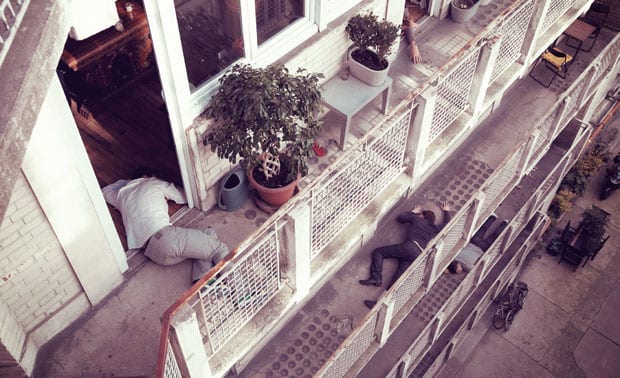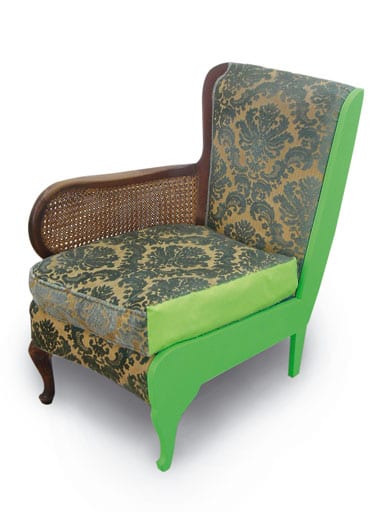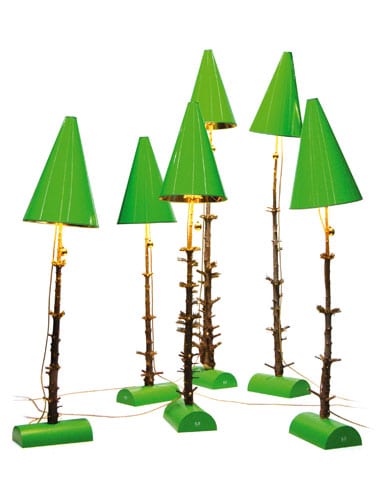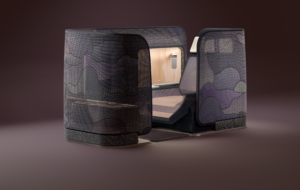
words Johanna Agerman
“We are happy to play design.”
“It’s a serious game and we like to be serious about playing,” announces Jean-Sébastien Blanc of 5.5 designers.
If the aim of the game is to create as much publicity as possible then 5.5 Designers is playing it well. This is the 181st piece written about the studio in the five years since its members joined forces as 23-year-old graduates. Its first work was a performance in which the designers donned white lab coats and carried out surgery on old, battered chairs by adding prosthetic legs and seats in a sickly chartreuse plastic. Since then it has gone more mainstream, making everything from porcelain to sponges. The French state holds several of its pieces in its design collection. But is there more to 5.5 Designers than the hype?
We meet in 5.5’s studio located in Paris’ tenth arrondissement, close to Gare de L’Est. It’s an area dominated by shops full of African goods with creative studios on the floors above. There is nothing “designed” about their office, instead it all seems to have come together as a result of an organic process: Ikea filing cabinets mix with second-hand furniture and their own designs. The stacks of paper and messy desks in the three rooms indicate that it’s either time for a big clear-out, or time to move. We sit down around the antique meeting room table and espresso is served in mismatched cups. “All of our projects are the topic of big talks around this table,” says Anthony Lebossé, tapping the glossy surface. “No ideas leave this table if someone isn’t happy,” he adds.
5.5 Designers are in fact just four – Jean-Sébastien Blanc, Vincent Baranger, Anthony Lebossé and Claire Renard. They met at École Nationale Supérieur d’Arts et Métiers in Paris and came up with the collective name 5.5 when they organised what they thought would be their last project together in the autumn of 2003. (At the time, the group had a fifth full-time member and a part-timer.) “In our minds it wasn’t planned, it wasn’t the beginning of something, it was just the end,” says Vincent Baranger. After this last performance, they would go their separate ways. But it didn’t work out like that.
The performance, Réanim: Object Medicine, had the designers playing furniture doctors. It prefigured a number of themes that have since become the preoccupations of the group: spectacle, an interest in making the production process visible and, above all, questioning consumption and the designer’s role in fuelling the want for new things. To 5.5’s surprise, Réanim was a huge success, prompting a welter of press coverage. Like a stage group faced with an unexpected hit, the studio took the production on tour for a year and a half, showing it at design fairs in Paris, New York, Milan and Tokyo.
“They were waiting for a new star in France when we graduated,” says Renard of their breakthrough. “All the designers here were already established.” The Réanim tour brought in commissions starting with an interior for the Galeries Lafayette department store in Paris, and helped crystallise 5.5 into the group that exists today. They now say that it’s impossible for them to work as individuals. “We all complement each other because we don’t really have the same personality and ability and we know that we can go faster if we are together,” says Lebossé. Seeing them together it becomes obvious that they are close friends as well as colleagues, and in fact Claire Renard and Jean-Sébastien Blanc are a couple. “But we’re not,” say Lebossé and Baranger, laughing. As a group they have a slightly geekier appearance than their reputation suggests, and the air of studenthood clings to them.
Most of 5.5’s projects are self-initiated rather than relying on commissions, and the group is more familiar with displaying in exhibitions than in shops. It gets so many requests to appear in exhibitions that it has developed 5.5m2, a flexible prefabricated exhibition system that allows you to order its work by the metre. “It was to show the way we were working and get the attention of people,” explains Lebossé of these self-generated projects. “And to get a sort of carte blanche from the companies we work with.” Jean-Sébastien Blanc agrees: “It’s only interesting to be a designer today if you do what you want, not what the companies tell you.”
With this creative freedom 5.5 has developed a variety of humorous and attention-grabbing pieces, such as Décor Vices, where the top of a fork, knife and spoon are screwed into unlikely objects such as remote controls. Another example is Ordinary Objects, a collection of unexpected combinations of products that amounts to a series of design one-liners. But beyond this gallery fodder, there are some ideas that manufacturers are picking up on.
Lebossé suddenly disappears into another room and returns with his hands full of different products that he carefully places on the table, all signed 5.5. “This is an exclusive,” he says as he demonstrates three not-yet-released USB sticks for technology company LaCie, which asked 5.5 to design a longer-lasting memory device. The result is a coin, a key and a large pill that splits in half and reveals one public and one private memory stick.
5.5 Designers can be very literal in its thinking, but the obviousness of its solutions is inventive rather than predictable. “We bring a naivety to every project,” says Baranger. “We ask the stupid questions, but sometimes that’s the best way of doing this.” In one project for sponge manufacturer Scotch Brite, each sponge is the shape of the object it’s supposed to be used for. But the group seems to find it hard to escape from “gift shop” design, a tendency it makes a virtue of in the Plaisir d’Offrir project. This, made for the Centre Pompidou shop, is a collection of boxes based on a self-deprecating remark by Philippe Starck about design being nothing more than Christmas presents. It’s a series of four fancy gift boxes which perform useful functions – an ash tray and a money box, for instance.
Some 5.5 projects do strive for greater relevance and attempt to explore the relationship we have with our possessions, a continuation of their first project together. In Milan earlier this year 5.5 presented another self-generated project, Cloning, in a rented space in Zona Tortona. Again donning white lab coats, the designers invited passers-by to come in for a consultation, having their torsos measured, their seating pattern scanned, their eye colour analysed, all to create custom made products that the consumer can form a closer bond with (icon 065). For Cloning they convinced several of their previous collaborators to work with them on these one-offs that are bespoke to each owner.
Two weeks after we meet, the French government announces that the country has slipped into recession. It’s curiously appropriate, as 5.5’s products can be read as a warning against over-consumption and disposability. Its most recent project, Save a Plate, saved 45,000 plastic plates from being destroyed. Back in 2004, a mass-market crockery manufacturer asked 5.5 to come up with a set of plastic plates. Ten days before the launch the company decided to axe the project and bin the plates that had already been manufactured. Instead of just taking their money and quietly accepting the disappointing outcome, 5.5 negotiated to buy the stock, which it is now flogging off with stickers saying “save a plate”. “It was more to show that now the designer can have a role in the future of their products,” says Lebossé, but it’s also evidence of a flair for marketing, turning a conventional exercise in product design into a promotional tool with a Barbara Kruger-esque critique of consumerism thrown in.
Although it has proved itself as one of France’s most interesting new design studios of the past five years, the significant commissions that will take it over the threshold to the grand salle of the design establishment are still missing. 5.5 is both winner and victim in the hunt for quick fixes, something that its members recognise themselves. “At the beginning we thought that it would have been better to have more experience of working with other designers,” says Baranger. “But now we are happy it worked out like it did, because we created our own career in some ways.”
Portrait byKourtney Roy




















